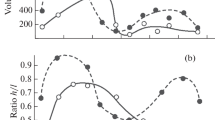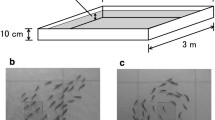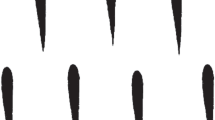Summary
The three-dimensional structure of schools of saithe (Pollachius virens) and the interactions between individuals over time were analyzed in 12,240 frames of videotape sampled at 2.7 Hz. Time series analyses of the interactions between identified individuals allowed testing of assumptions of anonymity vs. leadership in schools and investigation of the transfer of information between individuals by which collective decisions are made. Results include the following:
-
1.
Saithe match changes in both swimming direction and speed of their neighbors but correlations are greater for swimming speed. Average speed of the school does not greatly affect correlations between neighboring fish although the reaction latencies may be somewhat increased. As shown previously (Partridge et al. 1980) nearest neighbor distance (NND) decreases with increasing school velocity.
-
2.
Saithe simultaneously match the headings and swimming speeds of at least their first two nearest neighbors within the school (NN1 and NN2). Partialling out the correlation between a fish's neighbors demonstrates that a fish's correlation to his second nearest neighbor (NN2) is not simply a transitive function of mutual correlation between the NN1 and NN2.
-
3.
Several sources of individual variation in schooling performance were examined. In all respects except one, that of preferred positions within the school, saithe showed no individual differences, i.e., some were not “better schoolers” than others. Although fish in the school differed in length by up to a factor of 2.5, no size related effects in NND or nearest neighbor positioning were found.
-
4.
Single Linkage Cluster Analysis (SLCA) of the cross-correlations of fishs' swimming speeds and directions demonstrated quantitatively the existence of subgroups within schools if they contain more than 10–11 members. Subgroups acting more-or-less independently in terms of short term variations in speed and direction nonetheless remained within the school as a whole and were not often apparent to observers since members of one group interdigitated with those of another. How individuals know to which subgroup they belong remains unanswered.
Similar content being viewed by others
Abbreviations
- 3-D :
-
three-dimensional
- NN :
-
nearest neighbor
- NND :
-
nearest neighbor distance
- SLCA :
-
single linkage cluster analysis
References
Atz JW (1953) Orientation in schooling fishes. In: Schneiria TC (ed) Proceedings of a conference on orientation in animals. Office of Naval Research, U.S.N., Washington, DC, pp 115–130
Bainbridge R (1958) The speed of swimming fish as related to size and to the frequency and amplitude of the tail beat. J Exp Biol 35:109–133
Bateson W (1889) The sense-organs and perceptions of fish: with remarks on supply of bait. J Mar Biol Assoc UK 1:225–256
Breder CMJr (1929) Certain effects in the habits of schooling fishes as based on the observations ofJenkinsia. Am Mus Novit 382:1–5
Breder CMJr (1951) Studies on the structure of the fish school. Bull Am Mus Nat Hist 98:7–28
Breder CM Jr (1954) Equations descriptive of fish schools and other animal aggregations. Ecol 35:361–370
Breder CM Jr (1959) Studies on the social groupings of fish. Bull Am Mus Nat Hist 117:397–481
Breder CM (1965) Vortices and fish schools. Zoologica 50:97–114
Breder CM (1976) Fish schools as operational structures. Fish Bull 74:471–502
Cullen JM (1974) Statics and dynamics of a fish school. Abstract XIVth International Ethological Congress, Parma, Italy
Cullen JM, Shaw E, Baldwin H (1965) Methods for measuring the 3-D structure of fish schools. Anim Behav 13:534–543
Dijkgraaf S (1963) The functioning and significance of the lateral line organs. Biol Rev 38:51–67
Girsa II (1971) Alteration in the behaviour and vertical distribution of certain juvenile cyprinids in relation to illumination intensity and the presence of a predator. J Ichthyol 11:449–545
Gower JC, Ross GJ (1969) Minimum spanning trees and single linkage cluster analysis. Appl Stat 18:54–64
Gray SJ (1957) How fishes swim. Sci Am 197:48–54
Healey MC, Prieston R (1974) The interrelationships among individuals in a fish school. Fish Res Board Can Tech Rep 389:15
Helfman GS (1978) Patterns of community structure in fishes: summary and overview. Environ Biol Fish 3:129–148
Hunter JR (1966) Procedure for analysis of schooling behaviour. J Fish Res Board Can 23:547–562
Hunter JR (1969) Communication velocity changes in jack mackerelTrachurus symmetricus schools. Anim Behav 17:507–514
Hunter JR, Wisby WJ (1964) Net avoidance behavior by carp and other species of fish. J Fish Res Board Can 21:613–633
Inagaki T, Sakamoto W, Kuroki T (1976a) Studies on the schooling behaviour of fish. II. Mathematical modeling of schooling form depending on intensity of mutual force between individuals. Bull Jpn Soc Sci Fish 42:265–270
Inagaki T, Sakamoto W, Aoki I, Kuroki T (1976b) Studies on the schooling behaviour of fish. III. Mutual relationsip between speed and form in schooling behaviour. Bull Jpn Soc Sci Fish 42:629–635
John K (1973) Illumination, vision and schooling behaviour ofAstyanax mexicanis. J Fish Res Board Can 21:1453–1473
Keenleyside M (1955) Aspects of schooling behavior in fish. Behaviour 8:183–248
Kendall MG (1973) Time-series. Griffen, London
Major PF, Dill LM (1978) The three dimensional structure of airborne bird flocks. Behav Ecol Sociobiol 4:111–122
Mužinić R (1977) On the shoaling behavior of sardines (Sardina pilchardus) in aquaria. J Cons 42:147–155
Nursall JM (1973) Some behavioral interactions of spottail shiners (Notropis hudsonius), yellow perch (Perca flavescens) and Northern pike (Esox lucius). J Fish Res Board Can 30:1161–1178
Olst JC van, Hunter JR (1970) Some aspects of the organization of fish schools. J Fish Res Board Can 27:1225–1238
Oshima Y (1950) An experiment on the shoaling behavior of fish: the case when two homotypic shoals consisting of large and small individuals met with each other. Bull Jpn Soc Sci Fish 16:195–200
Parr EA (1927) A contribution to the theoretical analysis of the behavior of fishes. Occas Pap Bingham Ocean Coll 1:1–32
Partridge BL (1978) Sensory aspects of schooling. D Phil thesis, University of Oxford, 520 pp
Partridge BL (1980) The effect of school size on the structure and dynamics of minnow schools. Anim Behav 28:68–77
Partridge BL (1981) Lateral line function and schooling. In: Fay RR, Popper AN, Tavolga WN (eds) Hearing and sound communication in fishes. Springer, Berlin Heidelberg New York
Partridge BL, Cullen JM (1977) A low-cost interactive coordinate plotter. Behav Res Methods Instrum 9:473–479
Partridge BL, Pitcher TJ (1979) Evidence against a hydrodynamic function of fish schools. Nature 279:418–419
Partridge BL, Pitcher TJ (1980) The sensory basis of fish schools: relative roles of lateral line and vision. J Comp Physiol 135:315–325
Partridge BL, Pitcher TJ, Cullen JM, Wilson J (1980) The three dimensional structure of schools of saithe, cod and herring. Behav Ecol Sociobiol 6:277–288
Pitcher TJ (1979) Sensory information and the organization of behaviour in a shoaling cyprinid fish. Anim Behav 27:126–149
Pitcher TJ, Partridge BL (1979) Fish school density and volume. Mar Biol 54:83–94
Radakov DV (1958) On the adaptive significance of shoaling of young coal fish (Pollachius virens), Vopr Ikhtiol 11:69–74 (in Russian)
Radakov DV (1973) Schooling in the ecology of fish. Wiley, New York, p 173 (Israel Translation Series)
Radakov DV, Silva A (1974) Some characteristics of the schooling behavior ofJenkinsia lamprotaenia. J Ichthyol 14:283–286
Reese E (1978) The study of space related behavior in aquatic animals: special problems and selected examples. In: Reese E, Lighter F (eds) Contrasts in behavior. Wiley, New York, pp 347–376
Sakamoto W, Aoki I, Kinoki T (1975) Studies on the schooling behaviour of fish. I. Spectral analyses of interaction between two individuals of fish in locomotion. Bull Jpn Soc Sci Fish 41:945–952
Sakamoto W, Inagaki T, Kiroki T (1976) Studies of the schooling behaviour of fish. IV. Some discussions concerning continuity of swimming speed and response time of individuals. Bull Jpn Soc Sci Fish 42:1983–1991
Sale P (1978) Reef fishes and other vertebrates: A comparison of social structures. In: Reese E, Lighter F (eds) Contrasts in behavior. Wiley, New York, pp 313–346
Selous E (1931) Thought transference (or what?) in birds. Constable, London, p 139
Shaw E (1967) Some new thoughts on the schooling of fishes. FAO Fish Rep 62(2):217–233
Shaw E (1978) Schooling fishes. Am Sci 66:166–175
Siegel S (1956) Nonparametric statistics for the behavioral sciences. McGraw Hill, London
Sokal RR, Rohlf FJ (1969) Biometry. Freeman, San Francisco
Volkova LA (1972) Daily changes in the schooling behaviour of some Lake Baikal fish. J Ichthyol 12:596–607
Wardle CS (1975) Limits of fish swimming speed. Nature 255:725–727
Wardle CS (1977) Effects of size on the swimming speeds of fish. In: Pedley (ed) Scale effects in animal locomotion. Academic Press, New York, pp 229–313
Wardle CS, Anthony PD (1973) Experimental methods used for the study of fish behaviour in large tanks. ICES CM 1973/ B:22
Yamagishi H (1978) Behavioral studies on schooling in fishes. I. Leading-following relationship of the young golden trevally,Caranx speciosus in captivity. Zool Mag 87:12–18
Yamagishi H, Nakamurs M, Fukarhara O (1978) Behavioral studies on schooling of fishes II. Leading-following relationship of the immature Yellowtail,Seriola quinqueradiata Temminck et Schlegel, in captivity. Zool Mag 87:124–131
Author information
Authors and Affiliations
Additional information
The D.A.F.S. Marine Laboratory, Aberdeen, Scotland, kindly provided the use of the gantry tank and ancillary equipment without which the experiments could not have been done. Thanks are due to C.S. Wardle, A.D. Hawkins, V. Mojsiewiez, R.S. Batty, J. Wilson and especially to T.J. Pitcher for assistance during the experiments and to J. Skelton for helping plot the data. I am also grateful to R. Wassersug and C. Barnett for comments on the ms, and to R. Dawkins, M. Dawkins and J. Erichsen for helpful discussions. The work was supported by research grants from the Royal Society (Browne Foundation), the New University of Ulster Operating Committee and postgraduate fellowships from the National Science Foundation and the National Research Council of Canada. Computing facilities were provided by the Departments of Experimental Psychology and Zoology, University of Oxford, and the University of Miami.
Rights and permissions
About this article
Cite this article
Partridge, B.L. Internal dynamics and the interrelations of fish in schools. J. Comp. Physiol. 144, 313–325 (1981). https://doi.org/10.1007/BF00612563
Accepted:
Issue Date:
DOI: https://doi.org/10.1007/BF00612563




